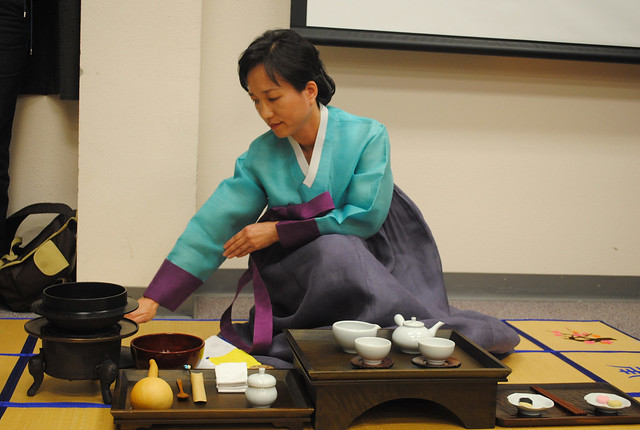
Living in a world with stressors and constantly moving from point A to point B, some people choose to immerse themselves in enjoying a cup of tea with friends. Some of these people practice the art of chanoyu, an ancient Japanese tea ceremony.
San Francisco, dubbed the “gateway to the East” by some, shares a 118 year-old history with Japanese tea culture. The city’s Golden Gate Park holds the oldest public tea garden in the United States, hosting tea ceremonies every Wednesday and Friday. Most recently, SF State and the University of San Francisco hosted a conference focusing on tea culture and ceremonies called Ocha Zanmai: San Francisco International Conference on Chanoyu and Tea Cultures.
The inaugural SFICCTC, which took place in Room 133 of the Humanities Building, was chaired by Midori McKeon, coordinator for the Japanese program at SF State. Focusing on the practices, history and cultural significance of Japanese and Korean tea ceremonies, the event fostered awareness and further educated people on the centuries old practice.
McKeon had four months to organize the conference and gained support from groups such as the Imuraya Group and the Consulate General of Japan in San Francisco. She believes that a conference focusing on tea is befitting of San Francisco, considering its history with tea culture.
“San Francisco has a vibrant eastern culture, which makes it the perfect place for this conference,” McKeon said. “Tea is learning about history, utensils and zen philosophy.”

Japanese tea ceremonies are called chanoyu, yet no word exists for “ceremony” in the Japanese language. Directly translated, chanoyu means “hot water with tea.” The ceremony, set in a tranquil, clean place with upwards of five people, can take anywhere from 40 minutes to 4 hours. The practice of chanoyu is about self-reflection and relating to others — all while having a cup of tea.
“Tea ceremonies entertain pleasure and the five senses in a purifying process,” McKeon said. “(They encourage you to) forget about everything in your mind, being here and now totally.”
Tsuyoshi Hikita, vice consul of cultural affairs at the Consulate General of Japan, takes part in tea ceremonies three to four times a year.
“It is a longstanding tradition that provides a deeper understanding of Japanese culture through peacefulness and communication,” Hikita said. “It’s all about calmness — we live in such a noisy world, but here it is so peaceful. We can heal.”
Though the practice of tea ceremonies is a century old tradition, it is evolving with the times.
“Tea is not static,” Jennifer Anderson, a guest speaker at the conference who lectures on anthropology at San Jose State University, said. “We can have a connection to the past (in tea ceremonies) by showing the ways of the past and providing visions of the future.”
Mika Sawada, a second-year SF State graduate student studying Japanese, attended the conference as a volunteer, but also came to learn about tea ceremonies. With fellow SF State student volunteers, Sawada worked the check-in table for the conference.
“I always wanted to learn about tea ceremonies and have never got the chance to take part in one,” Sawada said. “My favorite part of the conference was the Korean tea ceremony because it was beautiful the way they did it.”
Though the ceremonies have their roots in the eastern part of the world, McKeon and other presenters at the conference believe that the art has appeal that crosses cultural boundaries.
“I firmly believe that tea has the power to transcend borders, cultures and nations,” McKeon said.
Mckeon viewed her creation as a success with more than 160 guests in attendance.
“It was a great combination of wonderful presentations, enthusiasm and passion from the attendants,” McKeon said. “I’m thinking about doing it next year, depending on the comments I receive for the (guest) questionnaires.”



